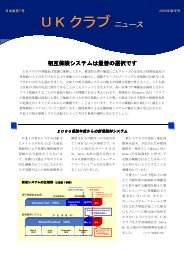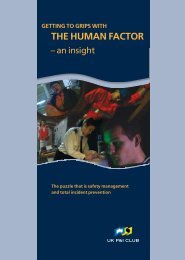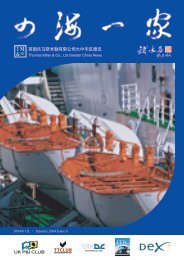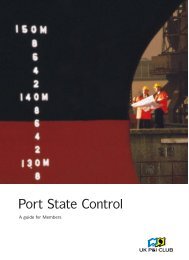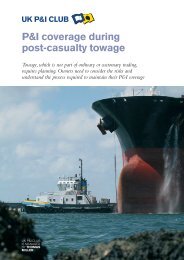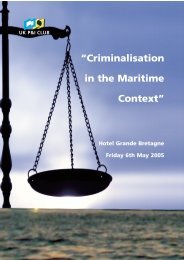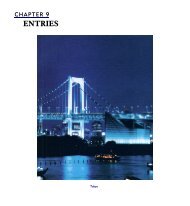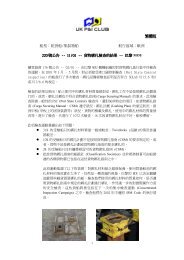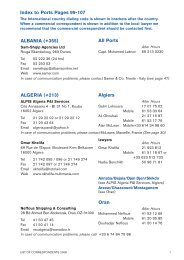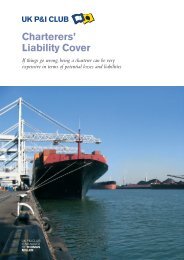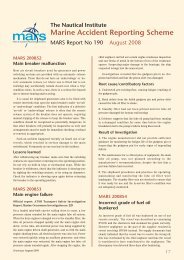Create successful ePaper yourself
Turn your PDF publications into a flip-book with our unique Google optimized e-Paper software.
■International Group of P&I Clubs, theClub’s Certificate of Entry will beaccepted. However the Certificate ofEntry must be an original.Report the status of insurance beforeentering a port or certain designatedsea areas.A report form must be filled out and faxedto the relevant district transport bureaubefore noon on the previous working daybefore the entry of the vessel in aJapanese port or entry into certaindesignated sea areas, these being TokyoBay, Isewan Bay and the Inland Sea. (Fordetails of the bureaux and the report formwhen it is available, visit MLIT’s website).MLIT’s announcement appears to indicatethat this notification requirement alsoapplies to CLC tankers.This article provides preliminary advicein response to queries from <strong>Members</strong>,but as noted above, since an Englishversion of the law is not available,<strong>Members</strong> are encouraged to visit the MLITwebsite for updated information and todownload the report form, when it is madeavailable. The website also includes theMLIT’s contact details and can be found atthe following address:www.mlit.go.jp/english/maritime/insurance_portal.htm ■..........................................................AUSTRALIAConfirmationof P&I entry<strong>Members</strong> who are trading to Australiashould be aware that the AustralianCustoms Service (ACS) is now insisting uponsighting a confirmation of ships’ P&I entryprior to granting them permission to sailfrom any Australian port.We have been advised of cases whereships have been delayed until the P&I Clubin question has provided a faxconfirmation. ACS stated that they wouldaccept fax copies of the confirmation until20 April 2004, after which ships should beable to produce an original certificate ofentry ■...............................................................................................................................................................................................................................................................................................case summaries(1) Mayban General Assurance BHD,(2) AMI Insurans BHD, (3) Malaysian NationalInsurance BHD, (4) Sharikat Takaful malaysiaBHD -v- (1) Alstom Power Plants Ltd, (2) AlstomT&D Ltd [2004] EWHC 1038 (Comm)-QBDQuery: Is inability of goods towithstand the ordinary perils of a seavoyage a new category of inherentvice?A transformer was shipped from EllesmerePort, <strong>UK</strong>, to Malaysia under an ‘all risks’cargo policy. When it arrived, it was foundseriously damaged and had to be returnedto the <strong>UK</strong> for repairs . The shipper lodged aclaim against his insurer alleging loss causedby some unusual event in the course of thevoyage. The insurers rejected the claimciting inherent vice on the basis of thetransformer’s inability to withstand theordinary incidents of carriage by sea fromthe <strong>UK</strong> to Malaysia during the wintermonths.On the facts, the weather conditionsencountered were not unusual and thetransformer had been properly secured.The evidence accepted by the court wasthat the joints of the transformer beganworking loose when subjected to stressesand strains of the kind that could beexpected to be encountered in the courseof carriage.Moore-Bick J pointed out that under an‘all risks’ policy, there are neverthelesslimits. Insurers accept the risk, but not thecertainty, of loss. A cargo that cannotwithstand prolonged exposure toconditions of that kind cannot be regardedas fit for the voyage. Damages caused bythe nature of the goods themselves ratherthan by an external cause would falloutside the remit of such a policy. Theinsurers were able to avoid payment underthe policy.The ‘CMA DJAKARTA’ – CMA CGM S.A.-v- Classica Shipping Co Ltd, Court of Appeal[2004]EWCA Civ 114A charterer cannot limit his liability inrespect of damage to shipA fire and explosion occurred onboard theCMA Djakarta in 1999 whilst she was ontime charter to CMA CGM for trading inCMA CGM’s liner service. The incident wasattributed to two containers filled withbleaching powder. The charterpartyprovided that the vessel was to beemployed in carrying lawful containerisedmerchandise “excluding any goods of adangerous, flammable or corrosivenature”.In the arbitration that followed, thearbitrators found the charterer in breachof the ‘dangerous cargo’ clause andupheld the owner’s claim for damages inthe sum of US$26.6m for repairs includingsalvage and owners’ demand to beindemnified in respect of all cargo claimsand general average contributions.The arbitrators ruled, following thedecision of Thomas J in the Aegean Sea[1998] that the charterer could not limit hisliability under the 1976 Conventionbecause his acts or omissions in relation tothe shipment of the cargo were acts oromissions done in his capacity as charterer,not as shipowner. The arbitrators’ decisionwas upheld by Steel J on appeal to theCommercial Court.The Court of Appeal has nowoverturned this decision. Longmore LJ whogave the leading judgment, said that hebelieved Steel J and Thomas J had both“started from the wrong point”. Inreaching their decision that the charterermust be acting “as an owner” before he isentitled to limit his liability, both judgesappeared to have relied to some extent onthe history of the United Kingdomlegislation and its incremental approach tocontinued over19




